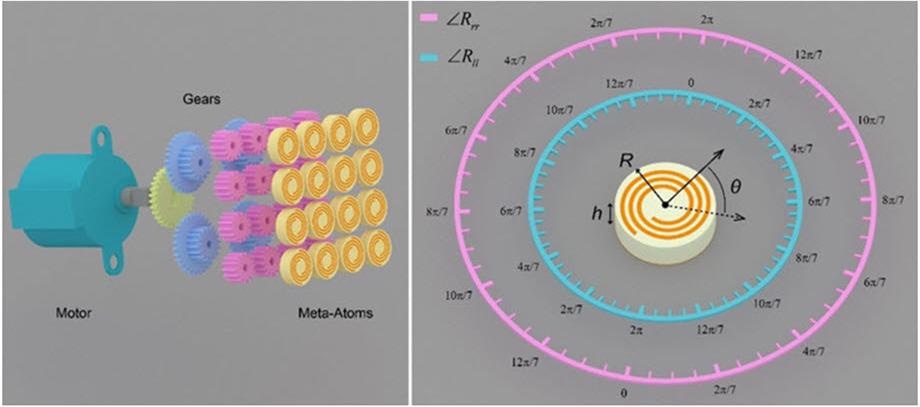Reviewed by Alex SmithFeb 7 2022
Reconfigurable intelligent surfaces (RISs) are a kind of programmable structure that could be used to control the regulation of electromagnetic waves by modifying the electric and magnetic properties of a surface. They propose a novel method for boosting the effectiveness of wireless communications systems—rather than adjusting to the propagation environment, they modify it.
 Schematic views of the RIS supercell and the meta-atom. Right: Geometric phase control in each supercell is achieved by transmitting the torque from a stepping motor to the meta-atoms through a set of gears. Left: Pink and sky-blue dials schematically depict the geometric phase control resolution and variation gradients for different circular polarizations. Image Credit: Xu et al.
Schematic views of the RIS supercell and the meta-atom. Right: Geometric phase control in each supercell is achieved by transmitting the torque from a stepping motor to the meta-atoms through a set of gears. Left: Pink and sky-blue dials schematically depict the geometric phase control resolution and variation gradients for different circular polarizations. Image Credit: Xu et al.
The combination of metallic resonators with digital equipment like PIN diodes and varactor diodes has propelled RIS research forward to a new level. With sub-wavelength resolution, RISs can now alter electromagnetic waves.
When used in combination with a field-programmable gate array, these RISs can be dynamically switched between varieties of functionalities in live time by just modifying the coding sequences.
Even then, there are problems with these diode-based RISs. First, the working principle of PIN/varactor diodes limits the degree of freedom of reconfiguration in the unit element scale: most are binary, and only a few can reach four.
Since a single diode's normal power consumption is in the hundreds of milliwatts range, sustaining functionality necessitates a constant power source.
Large-scale and long-term applications are hampered by such energy usage, which necessitates trade-offs between both the size or number of unit elements and the total RIS size.
An international research team has constructed a mechanical RIS with a high degree of reconfiguring freedom, cheap cost, and reduced energy consumption. The RIS runs at microwave frequencies and determines the rotation angle of each meta-atom using a reliable control approach. The study was published in the journal Advanced Photonics.
The RIS is made up of a 20 × 20 supercell that covers an area of 870 mm × 870 mm. A stepping motor, a set of transmission gears, and a 4 × 4 array of meta-atoms make up each supercell.
To accomplish the appropriate phase control, each meta-atom can be dynamically rotated. This reconfigurable feature enables a persistent and arbitrary phase control pattern with great efficiency and constant amplitude across the complete RIS.
By altering the RIS's operation in real-time across a number of capabilities, the researchers demonstrate effective and flexible control of the impinging wavefront. They show that the quasi-continuous phase tunability enhances wavefront controllability tremendously.
Modules and meta-atoms, capable of being mechanically reprogrammed, can be connected or disconnected in a variety of ways. Furthermore, the system maintains specified operation without requiring power, providing a new energy-saving and environmentally responsible option.
This RIS promises to achieve multidimensional manipulation of electromagnetic waves by incorporating different gear sets and different meta-atoms, which may bring RIS-related research to the next level.
Weili Zhang, Study Senior Author and Professor, Engineering, Oklahoma State University
Journal Reference:
Xu, Q., et al. (2022) Mechanically reprogrammable Pancharatnam–Berry metasurface for microwaves. Advanced Photonics . doi.org/10.1117/1.AP.4.1.016002.